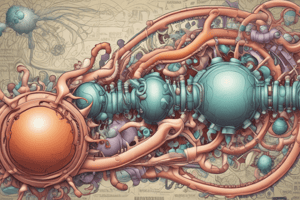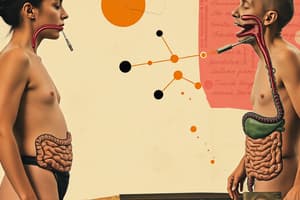Podcast
Questions and Answers
What is the primary site for nutrient absorption in the digestive system?
What is the primary site for nutrient absorption in the digestive system?
- Pancreas
- Large intestine
- Stomach
- Small intestine (correct)
Which enzyme produced by the pancreas is responsible for digesting proteins?
Which enzyme produced by the pancreas is responsible for digesting proteins?
- Bile
- Lipase
- Protease (correct)
- Amylase
What role does bicarbonate play in digestion?
What role does bicarbonate play in digestion?
- Absorb nutrients
- Store bile
- Neutralize stomach acid (correct)
- Digest fats
What digestive disorder is characterized by abdominal pain and changes in bowel habits?
What digestive disorder is characterized by abdominal pain and changes in bowel habits?
Which phase of digestion does the nervous system prepare the digestive system for food arrival through stimuli like sight and smell?
Which phase of digestion does the nervous system prepare the digestive system for food arrival through stimuli like sight and smell?
What is the main function of the large intestine in the digestive process?
What is the main function of the large intestine in the digestive process?
What impact do digestive disorders have on the digestive system?
What impact do digestive disorders have on the digestive system?
Which hormone-related process is NOT influenced by the nervous and endocrine systems?
Which hormone-related process is NOT influenced by the nervous and endocrine systems?
What role does mechanical digestion play in the digestive process?
What role does mechanical digestion play in the digestive process?
Which enzyme is responsible for breaking down carbohydrates in the mouth?
Which enzyme is responsible for breaking down carbohydrates in the mouth?
How does the pH level in the stomach impact chemical digestion?
How does the pH level in the stomach impact chemical digestion?
What is the primary function of the small intestine?
What is the primary function of the small intestine?
Which of the following processes is a form of mechanical digestion?
Which of the following processes is a form of mechanical digestion?
Which of these statements about enzymes is true?
Which of these statements about enzymes is true?
What is the primary role of the esophagus in digestion?
What is the primary role of the esophagus in digestion?
In which part of the digestive system does the mixing of chyme with pancreatic and liver enzymes occur?
In which part of the digestive system does the mixing of chyme with pancreatic and liver enzymes occur?
Flashcards
Mechanical Digestion
Mechanical Digestion
The mechanical process of breaking down food into smaller pieces to increase its surface area for chemical digestion.
Chemical Digestion
Chemical Digestion
The chemical process of breaking down food molecules into smaller, absorbable units using enzymes.
Enzymes
Enzymes
Biological catalysts that speed up chemical reactions without being consumed in the process. They have specific active sites that bind to specific substrates.
Duodenum
Duodenum
Signup and view all the flashcards
Peristalsis
Peristalsis
Signup and view all the flashcards
Digestion
Digestion
Signup and view all the flashcards
Absorption
Absorption
Signup and view all the flashcards
Small Intestine
Small Intestine
Signup and view all the flashcards
What does the pancreas do?
What does the pancreas do?
Signup and view all the flashcards
What does bile do?
What does bile do?
Signup and view all the flashcards
Where does most nutrient absorption happen?
Where does most nutrient absorption happen?
Signup and view all the flashcards
What does the large intestine do?
What does the large intestine do?
Signup and view all the flashcards
Where is poop stored?
Where is poop stored?
Signup and view all the flashcards
How does poop leave the body?
How does poop leave the body?
Signup and view all the flashcards
What are the different mechanisms for nutrient absorption?
What are the different mechanisms for nutrient absorption?
Signup and view all the flashcards
How do the nervous and endocrine systems affect digestion?
How do the nervous and endocrine systems affect digestion?
Signup and view all the flashcards
Study Notes
Overview of Digestion
- Digestion breaks down large, insoluble food molecules into smaller, soluble molecules for absorption into the bloodstream.
- This process includes mechanical and chemical breakdown.
- Mechanical digestion physically reduces food size, increasing surface area for chemical digestion.
- Chemical digestion uses enzymes to break down food into absorbable molecules.
Mechanical Digestion
- Mechanical digestion physically breaks down food without altering its chemical composition.
- Examples include:
- Mastication (chewing) in the mouth, reducing food size.
- Churning in the stomach, mixing food with gastric juices.
- Peristalsis, rhythmic muscle contractions moving food through the digestive tract.
- The goal is to increase the surface area for chemical digestion.
Chemical Digestion
- Chemical digestion uses enzymes to break down food into absorbable units.
- Different enzymes target different food types.
- Enzymes are biological catalysts, speeding up reactions without being consumed.
- Enzymes have specific active sites for binding to substrates.
- Digestive environment pH affects enzyme activity; different organs have different pH levels for specific enzyme function.
- Salivary amylase breaks down carbohydrates in the mouth.
- Pepsin breaks down proteins in the stomach.
- The small intestine uses various enzymes to break down carbohydrates, proteins, and fats (lipases).
Digestive Organs and Their Functions
- Mouth: Mechanical (chewing) and chemical (salivary amylase) digestion.
- Esophagus: Transports food to the stomach using peristalsis.
- Stomach: Stores, mixes food with gastric juices (pepsin and HCl), initiating protein digestion.
- Small Intestine: Major site of chemical digestion & nutrient absorption. Receives pancreatic and liver secretions.
- Duodenum: First part, mixes chyme (partially digested food) with pancreatic and liver enzymes.
- Jejunum and Ileum: Absorb nutrients into the bloodstream and lymphatic system.
- Pancreas: Produces enzymes (amylase, protease, lipase) for carbohydrate, protein, and fat digestion; produces bicarbonate to neutralize stomach acid.
- Liver: Produces bile, vital for fat digestion and absorption, stored in the gallbladder.
- Large Intestine: Absorbs water and electrolytes; forms and stores feces.
- Rectum: Stores feces.
- Anus: Eliminates feces.
Nutrient Absorption
- Absorption moves digested nutrients from the digestive tract into the bloodstream.
- The small intestine is the primary absorption site.
- Absorption methods include diffusion, osmosis, active transport, and facilitated diffusion.
- Absorbed nutrients are transported throughout the body for cellular use.
Digestive Disorders
- Digestive health can be affected by:
- Heartburn: Acid reflux from stomach to esophagus.
- Ulcers: Sores in the stomach or small intestine lining.
- Irritable bowel syndrome (IBS): Functional disorder with abdominal pain, bloating, and bowel changes.
- Inflammatory bowel disease (IBD): Chronic inflammation of the gastrointestinal tract (Crohn's and ulcerative colitis).
- Celiac disease: Immune response to gluten, damaging the small intestine.
- These disorders impair digestion and nutrient absorption.
Role of the Nervous and Endocrine System
- The nervous and endocrine systems control digestion.
- Hormones regulate enzyme secretion and peristalsis.
- Nervous signals also influence these processes.
- The cephalic phase prepares the digestive system for food via sight, smell, or thought.
Importance of a Healthy Digestive System
- A healthy digestive system is essential for overall well-being.
- It ensures proper nutrient absorption and utilization.
- It supports immune function.
- It plays a role in regulating blood sugar and cholesterol.
Studying That Suits You
Use AI to generate personalized quizzes and flashcards to suit your learning preferences.
Description
Explore the fascinating process of digestion, focusing on how food is mechanically broken down into smaller, manageable pieces. Understand the roles of chewing, churning, and peristalsis in increasing surface area for effective chemical digestion. This quiz will deepen your understanding of both mechanical and chemical facets of digestion.




